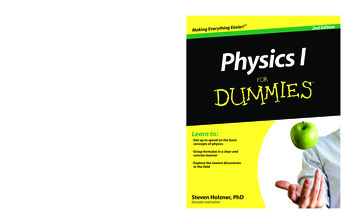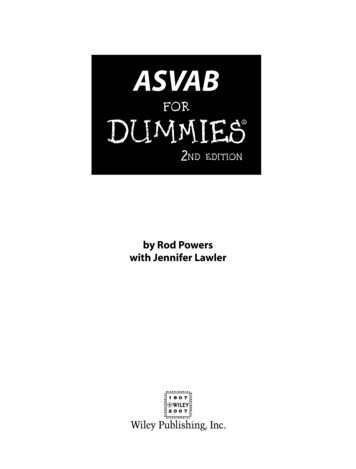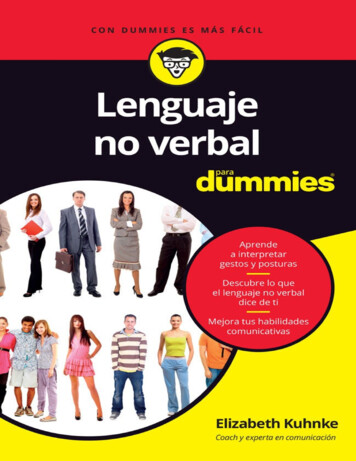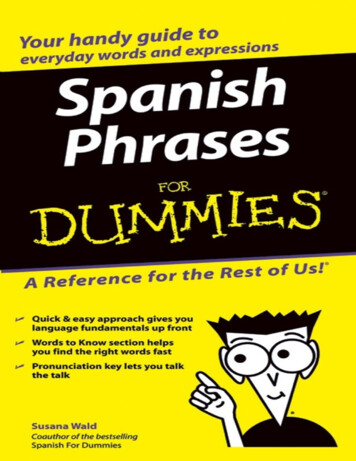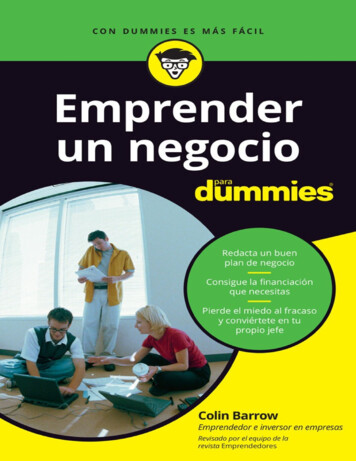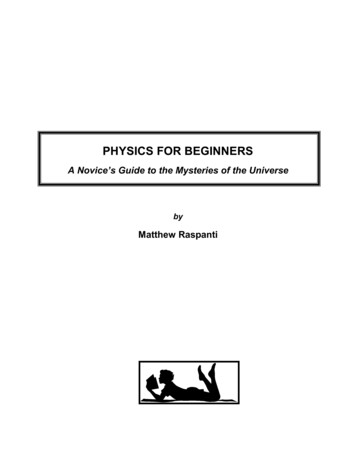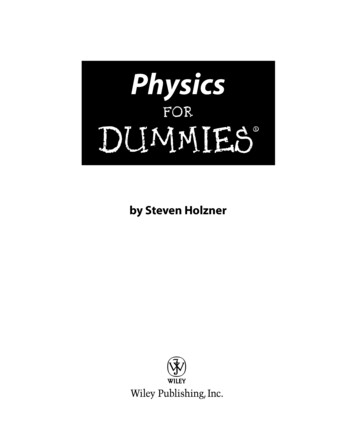
Transcription
PhysicsFORDUMmIESby Steven Holzner‰
Physics For Dummies Published byWiley Publishing, Inc.111 River St.Hoboken, NJ 07030-5774www.wiley.comCopyright 2006 by Wiley Publishing, Inc., Indianapolis, IndianaPublished by Wiley Publishing, Inc., Indianapolis, IndianaPublished simultaneously in CanadaNo part of this publication may be reproduced, stored in a retrieval system, or transmitted in any formor by any means, electronic, mechanical, photocopying, recording, scanning, or otherwise, except aspermitted under Sections 107 or 108 of the 1976 United States Copyright Act, without either the priorwritten permission of the Publisher, or authorization through payment of the appropriate per-copy fee tothe Copyright Clearance Center, 222 Rosewood Drive, Danvers, MA 01923, 978-750-8400, fax 978-646-8600.Requests to the Publisher for permission should be addressed to the Legal Department, Wiley Publishing,Inc., 10475 Crosspoint Blvd., Indianapolis, IN 46256, 317-572-3447, fax 317-572-4355, or online at http://www.wiley.com/go/permissions.Trademarks: Wiley, the Wiley Publishing logo, For Dummies, the Dummies Man logo, A Reference for theRest of Us!, The Dummies Way, Dummies Daily, The Fun and Easy Way, Dummies.com and related tradedress are trademarks or registered trademarks of John Wiley & Sons, Inc. and/or its affiliates in the UnitedStates and other countries, and may not be used without written permission. All other trademarks are theproperty of their respective owners. Wiley Publishing, Inc., is not associated with any product or vendormentioned in this book.LIMIT OF LIABILITY/DISCLAIMER OF WARRANTY: THE PUBLISHER AND THE AUTHOR MAKE NO REPRESENTATIONS OR WARRANTIES WITH RESPECT TO THE ACCURACY OR COMPLETENESS OF THE CONTENTS OF THIS WORK AND SPECIFICALLY DISCLAIM ALL WARRANTIES, INCLUDING WITHOUTLIMITATION WARRANTIES OF FITNESS FOR A PARTICULAR PURPOSE. NO WARRANTY MAY BE CREATED OR EXTENDED BY SALES OR PROMOTIONAL MATERIALS. THE ADVICE AND STRATEGIES CONTAINED HEREIN MAY NOT BE SUITABLE FOR EVERY SITUATION. THIS WORK IS SOLD WITH THEUNDERSTANDING THAT THE PUBLISHER IS NOT ENGAGED IN RENDERING LEGAL, ACCOUNTING, OROTHER PROFESSIONAL SERVICES. IF PROFESSIONAL ASSISTANCE IS REQUIRED, THE SERVICES OF ACOMPETENT PROFESSIONAL PERSON SHOULD BE SOUGHT. NEITHER THE PUBLISHER NOR THEAUTHOR SHALL BE LIABLE FOR DAMAGES ARISING HEREFROM. THE FACT THAT AN ORGANIZATIONOR WEBSITE IS REFERRED TO IN THIS WORK AS A CITATION AND/OR A POTENTIAL SOURCE OF FURTHER INFORMATION DOES NOT MEAN THAT THE AUTHOR OR THE PUBLISHER ENDORSES THE INFORMATION THE ORGANIZATION OR WEBSITE MAY PROVIDE OR RECOMMENDATIONS IT MAY MAKE.FURTHER, READERS SHOULD BE AWARE THAT INTERNET WEBSITES LISTED IN THIS WORK MAY HAVECHANGED OR DISAPPEARED BETWEEN WHEN THIS WORK WAS WRITTEN AND WHEN IT IS READ.For general information on our other products and services, please contact our Customer CareDepartment within the U.S. at 800-762-2974, outside the U.S. at 317-572-3993, or fax 317-572-4002.For technical support, please visit www.wiley.com/techsupport.Wiley also publishes its books in a variety of electronic formats. Some content that appears in print maynot be available in electronic books.Library of Congress Control Number: 2005933603ISBN-13: 978-0-7645-5433-9ISBN-10: 0-7645-5433-6Manufactured in the United States of America10 9 8 7 6 5 4 3 2 11B/RY/RR/QV/IN
About the AuthorSteven Holzner is an award-winning author of 94 books that have sold overtwo million copies and been translated into 18 languages. He served on thePhysics faculty at Cornell University for more than a decade, teaching bothPhysics 101 and Physics 102. Dr. Holzner received his Ph.D. in physics fromCornell and performed his undergrad work at MIT, where he has also servedas a faculty member.DedicationTo Nancy.Author’s AcknowledgmentsAny book such as this one is the work of many people besides the author. I’dlike to thank my acquisitions editor, Stacy Kennedy, and everyone else whohad a hand in the book’s contents, including Natalie Harris, Josh Dials, JoeBreeden, et al. Thank you, everyone.
Publisher’s AcknowledgmentsWe’re proud of this book; please send us your comments through our Dummies online registrationform located at www.dummies.com/register/.Some of the people who helped bring this book to market include the following:Acquisitions, Editorial, andMedia DevelopmentProject Editor: Natalie Faye HarrisAcquisitions Editor: Stacy KennedyCopy Editors: Josh Dials, Kristin DeMintTechnical Editor: Joseph L. BreedenEditorial Manager: Michelle HackerEditorial Assistants: Hanna Scott, Nadine Bell,David LuttonComposition ServicesProject Coordinator: Maridee EnnisLayout and Graphics: Mary J. Gillot,Denny Hager, Erin ZeltnerProofreaders: Laura Albert, Leeann Harney,Jessica Kramer, Arielle Mennelle,Joe Niesen, Carl William PierceIndexer: Joan GriffittsSpecial HelpDanielle VoirolCover Photos: Getty Images/PhotodiscCartoons: Rich Tennant (www.the5thwave.com)Publishing and Editorial for Consumer DummiesDiane Graves Steele, Vice President and Publisher, Consumer DummiesJoyce Pepple, Acquisitions Director, Consumer DummiesKristin A. Cocks, Product Development Director, Consumer DummiesMichael Spring, Vice President and Publisher, TravelKelly Regan, Editorial Director, TravelPublishing for Technology DummiesAndy Cummings, Vice President and Publisher, Dummies Technology/General UserComposition ServicesGerry Fahey, Vice President of Production ServicesDebbie Stailey, Director of Composition Services
Contents at a GlanceIntroduction .1Part I: Putting Physics into Motion .5Chapter 1: Using Physics to Understand Your World .7Chapter 2: Understanding Physics Fundamentals .13Chapter 3: Exploring the Need for Speed .25Chapter 4: Following Directions: Which Way Are You Going? .43Part II: May the Forces of Physics Be with You.61Chapter 5: When Push Comes to Shove: Force .63Chapter 6: What a Drag: Inclined Planes and Friction .81Chapter 7: Circling around Circular Motions and Orbits .99Part III: Manifesting the Energy to Work.117Chapter 8: Getting Some Work out of Physics .119Chapter 9: Putting Objects in Motion: Momentum and Impulse.137Chapter 10: Winding Up with Angular Kinetics .153Chapter 11: Round and Round with Rotational Dynamics.173Chapter 12: Springs-n-Things: Simple Harmonic Motion .189Part IV: Laying Down the Laws of Thermodynamics.205Chapter 13: Turning Up the Heat with Thermodynamics .207Chapter 14: Here, Take My Coat: Heat Transfer in Solids and Gases.219Chapter 15: When Heat and Work Collide: The Laws of Thermodynamics .235Part V: Getting a Charge out of Electricityand Magnetism.251Chapter 16: Zapping Away with Static Electricity .253Chapter 17: Giving Electrons a Push with Circuits .271Chapter 18: Magnetism: More than Attraction .287Chapter 19: Keeping the Current Going with Voltage .305Chapter 20: Shedding Some Light on Mirrors and Lenses .323
Part VI: The Part of Tens .339Chapter 21: Ten Amazing Insights on Relativity.341Chapter 22: Ten Wild Physics Theories.349Glossary.355Index .361
Table of ContentsIntroduction.1About This Book.1Conventions Used in This Book .2What You’re Not to Read.2Foolish Assumptions .2How This Book Is Organized.2Part I: Putting Physics into Motion .3Part II: May the Forces of Physics Be with You .3Part III: Manifesting the Energy to Work.3Part IV: Laying Down the Laws of Thermodynamics .3Part V: Getting a Charge out of Electricity and Magnetism.3Part VI: The Part of Tens .4Icons Used in This Book.4Where to Go from Here.4Part I: Putting Physics into Motion .5Chapter 1: Using Physics to Understand Your World . . . . . . . . . . . . . . .7What Physics Is All About .7Observing Objects in Motion.8Absorbing the Energy Around You .9Feeling Hot but Not Bothered.10Playing with Charges and Magnets .10Preparing for the Wild, Wild Physics Coming Up.11Chapter 2: Understanding Physics Fundamentals . . . . . . . . . . . . . . . . .13Don’t Be Scared, It’s Only Physics .14Measuring the World Around You and Making Predictions.15Don’t mix and match: Keeping physical units straight.16From meters to inches and back again:Converting between units.17Eliminating Some Zeros: Using Scientific Notation.20Checking the Precision of Measurements.21Knowing which digits are significant .21Estimating accuracy.22Arming Yourself with Basic Algebra .23Tackling a Little Trig .23
viiiPhysics For DummiesChapter 3: Exploring the Need for Speed . . . . . . . . . . . . . . . . . . . . . . . .25Dissecting Displacement .26Examining axes .27Measuring speed .28Speed Specifics: What Is Speed, Anyway?.29Reading the speedometer: Instantaneous speed .30Staying steady: Uniform speed .30Swerving back and forth: Nonuniform motion .30Busting out the stopwatch: Average speed .31Pitting average speed versus uniform motion.31Speeding Up (or Down): Acceleration .33Defining acceleration .33Determining the units of acceleration .33Positive and negative acceleration .35Average and instantaneous acceleration .36Uniform and nonuniform acceleration .37Relating Acceleration, Time, and Displacement .37Not-so-distant relations .38Equating more speedy scenarios .39Linking Speed, Acceleration, and Displacement .40Chapter 4: Following Directions: Which Way Are You Going? . . . . . .43Conquering Vectors .43Asking for directions: Vector basics .44Putting directions together: Adding vectors .45Taking distance apart: Subtracting vectors .46Waxing Numerical on Vectors.47Breaking Up Vectors into Components .49Finding vector components given magnitudes and angles.49Finding magnitudes and angles given vector components.51Unmasking the Identities of Vectors .53Displacement is a vector .54Velocity is another vector .54Acceleration: Yep, another vector.55Sliding Along on Gravity’s Rainbow: A Velocity Exercise.57Part II: May the Forces of Physics Be with You .61Chapter 5: When Push Comes to Shove: Force . . . . . . . . . . . . . . . . . . .63Forcing the Issue .63For His First Trick, Newton’s First Law of Motion .64Getting it going: Inertia and mass .65Measuring mass.65Ladies and Gentlemen, Newton’s Second Law of Motion .66Naming units of force.67Gathering net forces.67
Table of ContentsNewton’s Grand Finale: The Third Law of Motion .72Tension shouldn’t cause stiff necks:Friction in Newton’s third law.73Analyzing angles and force in Newton’s third law .75Finding equilibrium .77Chapter 6: What a Drag: Inclined Planes and Friction . . . . . . . . . . . . .81Don’t Let It Get You Down: Dealing with Gravity .81Leaning Vertical: An Inclined Plane .82Figuring out angles the easy way .83Playing with acceleration .84Getting Sticky with Friction .85Calculating friction and the normal force .86Conquering the coefficient of friction.86Understanding static and kinetic friction.87Handling uphill friction.89Determining How Gravity Affects Airborne Objects .94Going up: Maximum height .94Floating on air: Hang time .95Going down: Factoring the total time .95Firing an object at an angle .96Chapter 7: Circling around Circular Motions and Orbits . . . . . . . . . . .99Staying the Course: Uniform Circular Motion .100Changing Direction: Centripetal Acceleration.101Controlling velocity with centripetal acceleration .101Finding the magnitude of the centripetal acceleration .102Pulling Toward the Center: Centripetal Force .102Negotiating Curves and Banks: Centripetal Force through Turns.104Getting Angular: Displacement, Velocity, and Acceleration .106Dropping the Apple: Newton’s Law of Gravitation .108Deriving the force of gravity on the earth’s surface .109Using the law of gravitation to examine circular orbits .110Looping the Loop: Vertical Circular Motion .113Part III: Manifesting the Energy to Work .117Chapter 8: Getting Some Work out of Physics . . . . . . . . . . . . . . . . . . .119Work: It Isn’t What You Think .119Working on measurement systems .120Pushing your weight .120Taking a drag.121Considering Negative Work.122Getting the Payoff: Kinetic Energy .123Breaking down the kinetic energy equation .125Putting the kinetic energy equation to use .126Calculating kinetic energy by using net force.127ix
xPhysics For DummiesEnergy in the Bank: Potential Energy .128Working against gravity .129Converting potential energy into kinetic energy.130Choose Your Path: Conservative versus Nonconservative Forces .131Up, Down, and All Around: The Conservation of Mechanical Energy.132Determining final velocity with mechanical energy.134Determining final height with mechanical energy.134Powering Up: The Rate of Doing Work .135Common units of power .135Alternate calculations of power .136Chapter 9: Putting Objects in Motion: Momentum and Impulse . . . .137Looking at the Impact of Impulse.137Gathering Momentum.139The Impulse-Momentum Theorem: Relating Impulse andMomentum .140Shooting pool: Finding impulse and momentum.141Singing in the rain: An impulsive activity.142When Objects Go Bonk: Conserving Momentum.143Measuring velocity with the conservation of momentum .145Measuring firing velocity with the conservation of momentum.146When Worlds (or Cars) Collide: Elastic and Inelastic Collisions .148When objects bounce: Elastic collisions .148When objects don’t bounce: Inelastic collisions.149Colliding along a line.149Colliding in two dimensions.151Chapter 10: Winding Up with Angular Kinetics . . . . . . . . . . . . . . . . . .153Going from Linear to Rotational Motion .153Understanding Tangential Motion .154Finding tangential speed .154Finding tangential acceleration .156Finding centripetal acceleration.156Applying Vectors to Rotation .158Calculating angular velocity.158Figuring angular acceleration .159Twisting and Shouting: Torque.160Mapping out the torque equation .162Understanding lever arms.162Figuring out the torque generated .164Recognizing that torque is a vector .165No Wobbling Allowed: Rotational Equilibrium.166Hanging a flag: A rotational equilibrium problem .167Ladder safety: Introducing friction into rotational equilibrium.168Chapter 11: Round and Round with Rotational Dynamics . . . . . . . . .173Rolling Up Newton’s Second Law into Angular Motion.173Converting tangential acceleration to angular acceleration .175Factoring in the moment of inertia .175
Table of ContentsExamining Moments of Inertia.176CD players and torque: An inertia example .177Angular acceleration and torque: Another inertia example .179Wrapping Your Head around Rotational Work and Kinetic Energy .180Doing some rotational work.180Tracking down rotational kinetic energy .182Measuring rotational kinetic energy on a ramp .183Can’t Stop This: Angular Momentum.185Reviewing the conservation of angular momentum .186Satellite orbits: A conservationof angular momentum example .186Chapter 12: Springs-n-Things: Simple Harmonic Motion . . . . . . . . .189Hooking Up with Hooke’s Law .189Keeping springs stretchy.190Deducing that Hooke’s law is a restoring force .191Moving with Simple Harmonic Motion .191Examining basic horizontal and vertical simpleharmonic motion .192Diving deeper into simple harmonic motion .193Finding the angular frequency of a mass on a spring .200Factoring Energy into Simple Harmonic Motion .202Swinging with Pendulums .203Part IV: Laying Down the Laws of Thermodynamics .205Chapter 13: Turning Up the Heat with Thermodynamics . . . . . . . . . .207Getting into Hot Water.208When the thermometer says Fahrenheit.208When the thermometer says Celsius .208When the thermometer says Kelvin .209The Heat Is On: Linear Expansion.210Deconstructing linear expansion .212Workin’ on the railroad: A linear expansion example.212The Heat Continues On: Volume Expansion .213Going with the Flow (of Heat).214Changing Phases: When Temperatures Don’t Change .216Breaking the ice with phase changes.217Understanding latent heat.218Chapter 14: Here, Take My Coat: Heat Transferin Solids and Gases . . . . . . . . . . . . . . . . . . . . . . . . . . . . . . . . . . . . . . . . . .219Boiling Water: Convection.219Too Hot to Handle: Conduction.220Examining the properties that affect conductionto find the conduction equation .221Applying the heat-transferred-by-conduction equation.223xi
xiiPhysics For DummiesEmitting and Absorbing Light: Radiation.224You can’t see radiation, but it’s there .225Radiation and blackbodies.226Crunching Avogadro’s Number .228Forging the Ideal Gas Law .229Gas pressure: An ideal gas law example.231Boyle’s Law and Charles’ Law: Alternative expressionsof the ideal gas law .231Tracking Ideal Gas Molecules .232Predicting air molecule speed .232Calculating kinetic energy in an ideal gas .233Chapter 15: When Heat and Work Collide:The Laws of Thermodynamics . . . . . . . . . . . . . . . . . . . . . . . . . . . . . . . .235Gaining Thermal Equilibrium: The Zeroth Law of Thermodynamics .235Conserving Heat and Energy: The First Law of Thermodynamics .236Calculating conservation.237Examining isobaric, isochoric, isothermal,and adiabatic processes, oh my! .238Figuring out specific heat capacities .245When Heat Flows: The Second Law of Thermodynamics.246Putting heat to work: Heat engines .246Evaluating heat’s work: Heat engine efficiency .247Carnot says you can’t have it all .248Going Cold: The Third (and Absolute Last) Law of Thermodynamics .250Part V: Getting a Charge out of Electricityand Magnetism .251Chapter 16: Zapping Away with Static Electricity . . . . . . . . . . . . . . .253Plus and Minus: Electron and Proton Charges .253Push and Pull: Electric Forces .254Charging it to Coulomb’s law .255Bringing objects together.255Calculating the speed of electrons.256Looking at forces between multiple charges .256Influence at a Distance: Electric Fields.258Coming from all directions: Electric fieldsfrom point charges .259Charging nice and steady: Electric fieldsin parallel plate capacitors.261Electric Potential: Cranking Up the Voltage.262Calculating electric potential energy .263Realizing the potential in voltage .
Joyce Pepple, Acquisitions Director, Consumer Dummies Kristin A. Cocks, Product Development Director, Consumer Dummies Michael Spring, Vice President and Publisher, Travel Kelly Regan, Editorial Director, Travel Publishing for Technology Dummies Andy Cummings, Vice President and Publisher, Dumm
